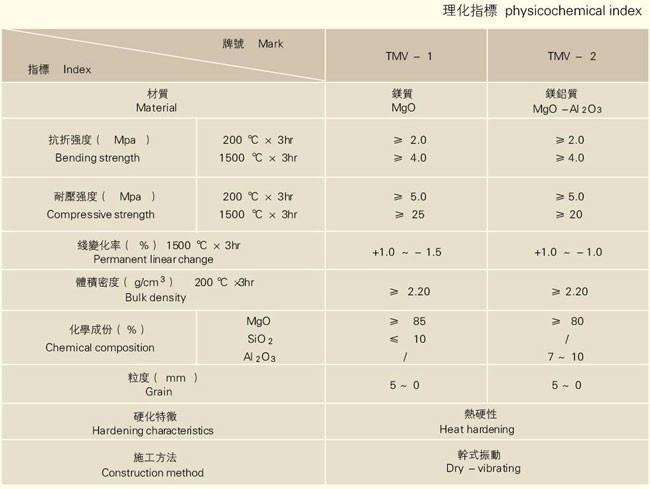Telephone:
+86 0417-3909999
Fax:
+86 0417-3909999
Contact:
Mr. Liu
website : en.ykblnc.com
company website:
www.ykblnc.com
E-mail:
bllzj888@163.com
address:
19-1 East, North Line, Yingda Road, Laobian District, Yingkou City, Liaoning Province
Sintered magnesia is used as the main raw material, the particle composition is designed according to the most complicated packing principle, the thermosetting solid resin is added as the low-temperature binder, and the moderate amount of medium-temperature sintering agent is added to make the material have good strength under different temperature conditions, which is an alternative. Ideal for insulation panels and magnesium enamels. The product has the characteristics of fast construction, excellent corrosion resistance and long service life.

The tundish refractory lining mainly comprises a heat insulating layer and a working layer. Electric furnace spray
(1) Insulation layer (insulation layer) (10 to 30 mm). This layer is next to the tundish steel shell. The main function is to keep the molten steel warm and reduce the temperature drop of the molten steel during the pouring process. Usually, it is made of asbestos board, heat preservation brick or light castable. The effect is aluminum silicate fiber felt, which has low thermal conductivity and is easy to masonry.
(2) Working layer (20 to 50 mm). This layer is in contact with molten steel and is a key part. During the use process and construction process, the material of the layer should be simple in equipment, convenient in construction, can reduce labor intensity, improve labor productivity, and have good baking adaptability, and require the work lining material to harden quickly and not burst when baking. It has good strength, can be quickly baked or can be directly used without baking. It can reduce the energy consumption of the baking package and increase the utilization rate of the tundish, prolong the use period of the middle bag and reduce the number of spare bags. The working lining material should have good adhesion during construction, and will not fall back or collapse. It should have good high temperature performance under high temperature conditions. It requires not only high refractoriness and high temperature strength, but also good chemical stability. It does not cause secondary oxidation of molten steel under high temperature conditions. It will pollute the molten steel without reducing the quality of the billet. It should have good resistance to slag erosion and penetration during use, as well as resistance to molten steel and slag scouring, which will help to improve the service life of the medium lining work lining and reduce the tundish.
The consumption of refractory materials reduces the pollution of refractory materials to molten steel. The working lining should have a certain metallurgical function, which can react with the inclusions in the molten steel, absorb the N, S, P and non-metal oxide inclusions in the molten steel, and improve the quality of the molten steel. The working lining should have good thermal shock resistance and good volume stability. It does not burst when it comes into contact with molten steel, ensuring good integrity of the tundish. The tundish working lining should also have a lower thermal conductivity, better thermal insulation performance, can reduce the heat loss of the middle bag, and keep the temperature of the tundish molten steel stable. The working lining after use should be easy to unpack and the working layer can be easily detached, which can reduce the damage of the working lining refractory material to the tundish and help to prolong the service life of the middle bag.
In the early stage of the working layer, aluminum refractory bricks were used. Later, in order to keep the temperature of the molten steel in the tundish not exceeding 15 °C when the molten steel was poured, the working layer began to use the insulation lining of the insulation board, and then the insulation board was fire-resistant with the same function. Instead of the application of smear and refractory spray coatings, with the development of multi-furnace continuous casting technology and rapid nozzle replacement technology, the latest dry vibrating materials have begun to replace refractory spray coatings with significant advantages. The tundish working layer has experienced the development of refractory clay bricks, insulation panels, spray coatings (smear) and the latest dry vibrating materials (ie dry working linings). The material of the insulation board is generally siliceous, magnesia and forsterite; other forms of refractory materials are mostly magnesia, magnesia and magnesia.
(4) The material of the bottom is basically equivalent to the working layer. The working layer at the bottom of the intermediate bag is easily damaged by the impact of the molten steel, and it is required to resist erosion and wear. The impact parts of molten steel are mostly reinforced with precast blocks, and the materials are corundum and magnesia castables, and some enterprises use the abandoned skateboard bricks and magnesia carbon bricks for reinforcement in the castables.